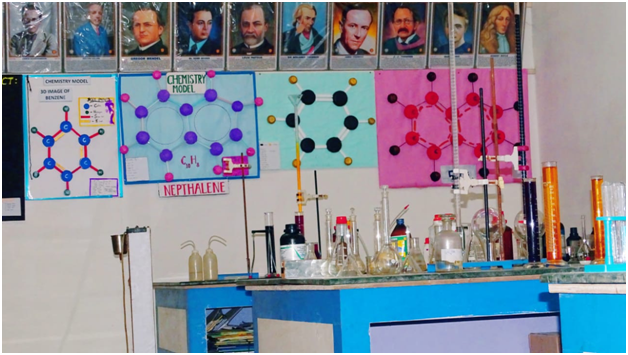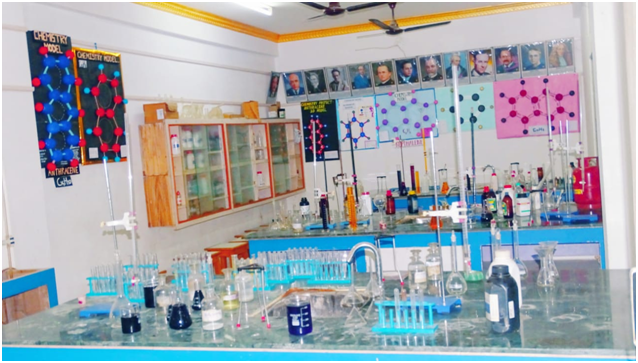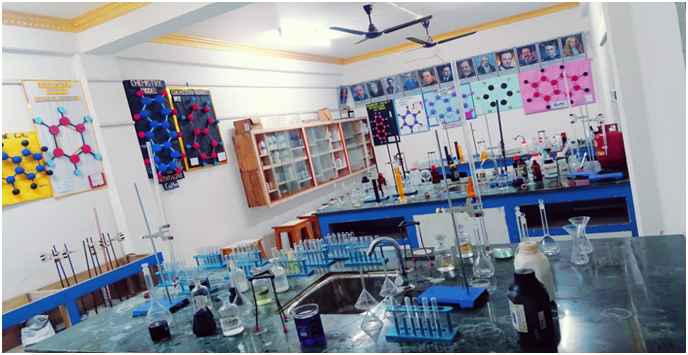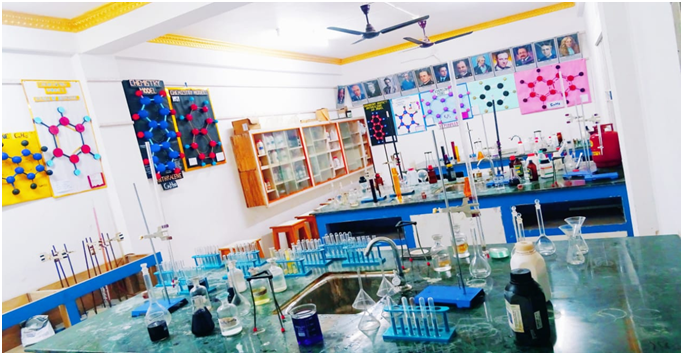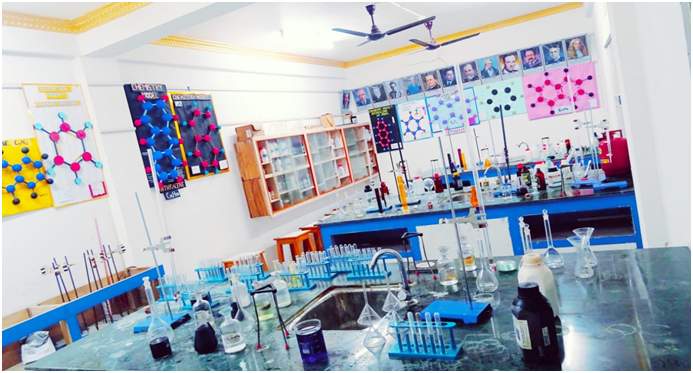| PRACTICAL FOR CLASS – XI | |
|---|---|
| Max. Marks : 30 | Time : 3 Hours |
| Evaluation Scheme | |
| Volumetric Analysis | 8 Marks |
| Salt Analysis | 8 Marks |
| Content Based Experiment | 6 Marks |
| Project Work | 4 Marks |
| Class record and viva | 4 Marks |
| TOTAL | 30 Marks |
PRACTICAL SYLLABUS : 60 Periods
Micro-chemical methods are available for several of the practical experiments, wherever possible such techniques should be used.
A . Basic Laboratory Techniques
- Cutting glass tube and glass rod.
- Bending a glass tube.
- Drawing out a glass jet .
- Boring a cork.
B . Characterization and Purification of Chemical Substances
- Determination of melting point of an organic compound.
- Determination of boiling point of an organic compound.
- Crystallization of impure sample of any one of the following: Alum, Copper Sulphate, Benzoic Acid.
C . Experiments based on pH
a ) Any one of the following experiments :
- Determination of pH of some solutions obtained from fruit juices, solution of known and varied concentrations of acids, bases and salts using pH paper or universal indicator..
- Comparing the pH of solutions of strong and weak acids of same concentration.
- Study the pH change in the titration of a strong base using universal indicator.
b ) Study the pH change by common-ion in case of weak acids and weak bases.
D. Chemical Equilibrium One of the following experiments :
a ) Study the shift in equilibrium between ferric ions and thiocyanate ions by increasing/decreasing the concentration of either of the ions.
b ) Study the shift in equilibrium between [Co(H2O)6]2+ and chloride ions by changing the concentration of either of the ions.
E. Quantitative Estimation
- Using a mechanical balance/electronic balance.
- Preparation of standard solution of Oxalic acid.
- Determination of strength of a given solution of Sodium hydroxide by titrating it against standard solution of Oxalic acid.
- Preparation of standard solution of Sodium carbonate.
- Determination of strength of a given solution of hydrochloric acid by titrating it against standard Sodium Carbonate solution.
F. Qualitative Analysis
a ) Determination of one anion and one cation in a given salt Cations- Pb2+, Cu2+, As3+, Al3+, Fe3+, Mn2+, Ni2+, Zn2+, Co2+, Ca2+, Sr2+, Ba2+, Mg2+, NH4+ Anions – (CO3)2- , S2-, NO2- , SO32-, SO2-4, NO3- , Cl- , Br-, I-, PO43- , C2O2-4, CH3COO- (Note: Insoluble salts excluded)
b ) Detection of -Nitrogen, Sulphur, Chlorine in organic compounds.
PROJECTS
Scientific investigations involving laboratory testing and collecting information from other sources.
A few suggested Projects- Checking the bacterial contamination in drinking water by testing sulphide ion.
- Study of the methods of purification of water
- Testing the hardness, presence of Iron, Fluoride, Chloride, etc., depending upon the regional variation in drinking water and study of causes of presence of these ions above permissible limit (if any).
- Investigation of the foaming capacity of different washing soaps and the effect of addition of Sodium carbonate on it
- Study the acidity of different samples of tea leaves.
- Determination of the rate of evaporation of different liquids
- Study the effect of acids and bases on the tensile strength of fibers.
- Study of acidity of fruit and vegetable juices.
Note: Any other investigatory project, which involves about 10 periods of work, can be chosen with the approval of the teacher.
| PRACTICAL FOR CLASS – XII | |
|---|---|
| Max. Marks : 30 | Time : 3 Hours |
| Evaluation Scheme | |
| Volumetric Analysis | 8 Marks |
| Salt Analysis | 8 Marks |
| Content Based Experiment | 6 Marks |
| Project Work | 4 Marks |
| Class record and viva | 4 Marks |
| TOTAL | 30 Marks |
PRACTICAL SYLLABUS : 60 Periods
Micro-chemical methods are available for several of the practical experiments. Wherever possible, such techniques should be used.
A . Surface Chemistry
- Preparation of one lyophilic and one lyophobic sol
Lyophilic sol - starch, egg albumin and gum
Lyophobic sol - aluminium hydroxide, ferric hydroxide, arsenous sulphide. - Dialysis of sol-prepared in (a) above.
- Study of the role of emulsifying agents in stabilizing the emulsion of different oils.
B . Chemical Kinetics
- Effect of concentration and temperature on the rate of reaction between Sodium Thiosulphate and Hydrochloric acid.
- Study of reaction rates of any one of the following: (i) Reaction of Iodide ion with Hydrogen Peroxide at room temperature using different concentration of Iodide ions.
(ii)Reaction between Potassium Iodate, (KIO3) and Sodium Sulphite: (Na2SO3) using starch solution as indicator (clock reaction).
C . Thermochemistry Any one of the following experiments
- Enthalpy of dissolution of Copper Sulphate or Potassium Nitrate.
- Enthalpy of neutralization of strong acid (HCI) and strong base (NaOH).
- Determination of enthaply change during interaction (Hydrogen bond formation) between Acetone and Chloroform.
D . Electrochemistry
- Variation of cell potential in Zn/Zn2+|| Cu2+/Cu with change in concentration of electrolytes (CuSO4 or ZnSO4) at room temperature.
E . Chromatography
- Separation of pigments from extracts of leaves and flowers by paper chromatography and determination of Rf values.
- Separation of constituents present in an inorganic mixture containing two cations only (constituents having large difference in Rf values to be provided).
F. Preparation of Inorganic Compounds
Preparation of double salt of Ferrous Ammonium Sulphate or Potash Alum. Preparation of Potassium Ferric Oxalate.
G . Preparation of Organic Compounds
Preparation of any one of the following compounds
ii) Di -benzalAcetone
iii) p-Nitroacetanilide
iv) Aniline yellow or 2 - Naphthol Anilinedye
H . Tests for the functional groups present in organic compounds:
Unsaturation, alcoholic, phenolic, aldehydic, ketonic, carboxylic and amino (Primary) groups.
I. Characteristic tests of carbohydrates, fats and proteins in pure samples and their detection in given foodstuffs.
J . Determination of concentration/ molarity of KMnO4 solution by titrating it against a standard solution of:
ii) Ferrous Ammonium Sulphate (Students will be required to prepare standard solutions by weighing themselves).
K . Qualitative analysis Determination of one cation and one anion in a given salt.
Cation : Pb2+, Cu2+ As3+, Aℓ3+, Fe3+, Mn2+, Zn2+, Cu2+, Ni2+, Ca2+, Sr2+, Ba2+, Mg2+, NH4+ Anions: (CO3)2-, S2-, (SO3)2-, (NO2)-, (SO4)2-, Cℓ-, Br-, I-, PO3-4, (C2O4)2-, CH3COO-,NO3- (Note: Insoluble salts excluded)
PROJECTS
Scientific investigations involving laboratory testing and collecting information from other sources.
A few suggested Projects- Study of the presence of oxalate ions in guava fruit at different stages of ripening.
- Study of quantity of casein present in different samples of milk.
- Preparation of soybean milk and its comparison with the natural milk with respect to curd formation, effect of temperature, etc.
- Study of the effect of Potassium Bisulphate as food preservative under various conditions (temperature, concentration, time, etc.)
- Study of digestion of starch by salivary amylase and effect of pH and temperature on it.
- Comparative study of the rate of fermentation of following materials: wheat flour, gram flour, potato juice, carrot juice, etc.
- Extraction of essential oils present in Saunf (aniseed), Ajwain (carum), Illaichi (cardamom).
- Study of common food adulterants in fat, oil, butter, sugar, turmeric power, chilli powder and pepper. Note: Any other investigatory project, which involves about 10 periods of work, can be chosen with the approval of the teacher.
